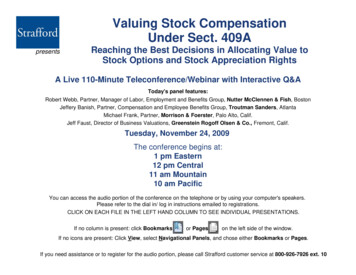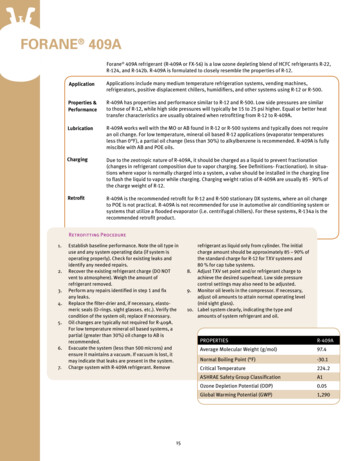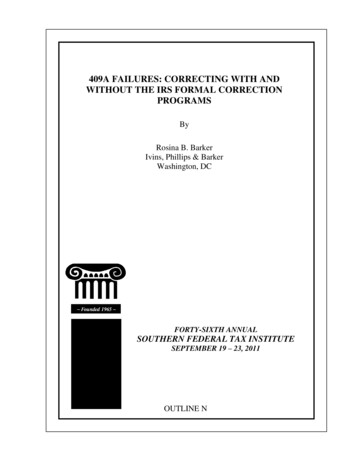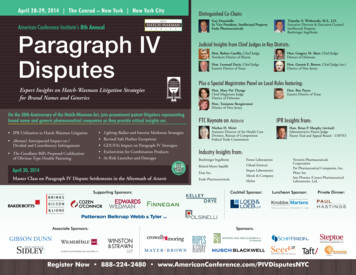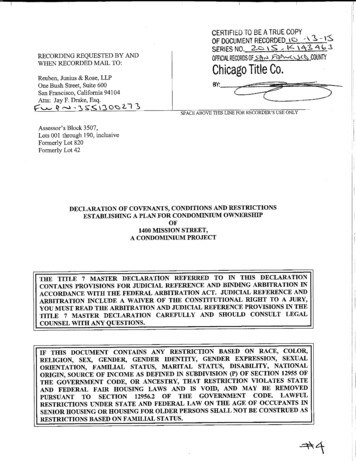
Transcription
Law DepartmentPRACTICAL LAW COMPANY PLCApplying Section 409A toSeverance BenefitsThis Article was first publishedby Practical Law Companyon its PLCLaw Departmentweb serviceat http://usld.practicallaw.com/6-501-2702This Note explains the application of Internal Revenue Code section 409A relating to nonqualifieddeferred compensation plans to various types of severance benefits.Durward J. "Jim" Gehring, Seyfarth Shaw LLPSection 409A of the Internal Revenue Code and its relatedregulations (Section 409A) provide comprehensive rulesgoverning the taxation of nonqualified deferred compensation.Very generally, "deferred compensation" is broadly defined asany form of compensation which is payable in the year afterthe year in which the legal right to payment arises. Severancepayments are considered a form of deferred compensationsubject to Section 409A unless an exception or exemptionapplies. Failure to comply with Section 409A results in fulltaxation of all deferred compensation of the same type,plus a 20% penalty tax, plus interest if compensation wasdeferred in a year before the year of the violation. This Note describes different types of severance benefitsand explains when and how they are subject to the rules ofSection 409A.For more information, see Practice Note, Section 409A:Deferred Compensation Tax Rules (www.practicallaw.com/6501-2009).SEVERANCE BENEFITS SUBJECT TO SECTION409A on a specified date or fixed schedule; death; separation of service (see Separation From Service); disability; change of control; or unforeseen emergency. Elections of the form of payment must be made beforethe year in which compensation is earned. Employer and employee discretion about the time andform of payment is no longer allowed. Certain terms such as "separation from service" and"change of control" must match the definitions outlinedin Section 409A.Section 409A applies to independent contractors (includingdirectors) as well as employees (see Practice Note, Section409A: Deferred Compensation Tax Rules: Basic Section409A Requirements (www.practicallaw.com/6-501-2009)).The general rule is that severance benefits are a form ofdeferred compensation subject to Section 409A unless anexception or exemption applies. The fact that severanceis subject to Section 409A does not in itself result in anytax penalties. However, severance benefits that are subjectto Section 409A must satisfy the requirements of Section409A, including the following: Payments must be triggered by one of the paymentevents permitted by Section 409A:Separation from ServiceGenerally, the most common Section 409A payment event givingrise to severance benefits is a "separation from service". However,the Section 409A definition may or may not be different from thecompany's practice on termination of employment.No payments that are triggered by a termination ofemployment or a separation from service can be madeto a "specified employee" (see Practice Note, SpecifiedEmployees Under IRC Section 409A (www.practicallaw.com/7-501-1330)) of a publicly-traded company untilsix months after termination.Under Section 409A, a separation from service occurs whenthe employer and employee anticipate one of the following atthe time of the termination of employment:Practical Law Company provides practical resources for business lawyers. To find out more about us and register for a free trial, please visit www.practicallaw.com/usCopyright 2010 Practical Law Publishing Limited and Practical Law Company, Inc. All Rights Reserved. Use of PLC websitesand services is subject to the Terms of Use (us.practicallaw.com/2-383-6690) and Privacy Policy (us.practicallaw.com/8-383-6692).1
Law DepartmentPRACTICAL LAW COMPANY PLC The employee will not perform any further services aftera certain date. The level of services that the employee will performafter a certain date (whether as an employee or anindependent contractor) is no more than 20% of theaverage level of services the employee performed in theprevious 36 months.severance benefits that the company can eliminate at anytime before the termination. Most broad-based severanceplans are designed in this manner and are exempt fromSection 409A if the severance pay is paid in a lumpsum shortly after termination. If severance pay is paid ininstallments that could be paid in years after the year oftermination, the severance pay may be subject to Section409A unless it meets one of the other exceptions.In general, a separation from service requires an 80%reduction in the average level of services, but agreementsmay provide a threshold of as low as 50%.For the same reason, severance benefits that are negotiatedat the time of termination, to which the employee had noprevious legal right, are also not subject to Section 409A.However, if the severance benefits are in lieu of other rightsthat were subject to Section 409A, the severance benefitsare then subject to Section 409A as well (see PracticeNote, Section 409A: Deferred Compensation Tax Rules:Substitution Constitutes a Deferral of Compensation (www.practicallaw.com/6-501-2009)).If an employee has been terminated but continues to performservices as a consultant or in another capacity for the employeror any affiliate, the employee may not have a separation fromservice if the level of services is above the threshold level.However, a change in status from director to employee or viceversa can qualify as a separation from service.Disputes About EntitlementAn employee who ceases to perform services but is kept on thepayroll for other purposes (for example, continuation of medicalcoverage) has separated from service (see Practice Note,Section 409A: Deferred Compensation Tax Rules: Separationfrom Service (www.practicallaw.com/6-501-2009)).If there is a bona fide dispute concerning the employee'sentitlement to a form of compensation that is otherwisesubject to Section 409A, a lump sum payment in settlementof the dispute does not violate the rule against acceleratingpayment of deferred compensation provided that theamount paid does not exceed 75% of the employee's claim.For example, assume an executive has an employmentagreement providing that he be paid two years of base salaryin installments if terminated without cause and that the totalamount of payments to which the executive is entitled is 1 million. If the company and the executive have a bonafide dispute about whether he was terminated for cause andthey agree to settle the dispute by a lump sum paymentof 500,000, the payment in a lump sum does not violateSection 409A even though an accelerated payment ofdeferred compensation is generally prohibited.Tax Reporting of Severance PaySeverance pay must generally be reported on Form W-2(or Form 1099-MISC for an independent contractor) in theyear of termination rather than the year of payment if it issubject to Section 409A. While this does not mean that itis taxable in the year of termination, it must be reported.However, the IRS has waived this reporting requirementuntil it finalizes the regulations on reporting compensationsubject to Section 409A.SEVERANCE BENEFITSSECTION 409AEXEMPTFROMPayments Satisfying the Short-term Deferral RuleCertain types of severance benefits are exempt from Section409A because they do not involve the deferral of compensation.Other types of severance benefits may be exempt underspecial rules. Severance benefits can be exempt from theSection 409A rules under the following circumstances.Payments made within a short time frame after theclose of a year are not deferred compensation. This iscalled the short-term deferral rule. If the employer usesa calendar year, compensation that is paid no later thanMarch 15 after the year in which the employee's right tocompensation is no longer subject to a substantial risk offorfeiture is exempt under the short-term deferral rule (seePractice Note, Section 409A: Deferred Compensation TaxRules: Substantial Risk of Forfeiture (www.practicallaw.com/6-501-2009)). If the employer uses a fiscal year, theNo Legally Binding Right to CompensationIf the employee has no legally binding right to receivecompensation in a future year, there is no deferredcompensation in the first place. This is the case withPractical Law Company provides practical resources for business lawyers. To find out more about us and register for a free trial, please visit www.practicallaw.com/usCopyright 2010 Practical Law Publishing Limited and Practical Law Company, Inc. All Rights Reserved. Use of PLC websitesand services is subject to the Terms of Use (us.practicallaw.com/2-383-6690) and Privacy Policy (us.practicallaw.com/8-383-6692).2
Law DepartmentPRACTICAL LAW COMPANY PLCcompensation must be paid by the later of March 15 or 2½months after the end of the employer's fiscal year. Applyingthe short-term deferral rule to severance payments meansthat severance must be paid no later than March 15 of theyear following the year in which the right to the severanceis no longer subject to a substantial risk of forfeiture (seeSubstantial Risk of Forfeiture).Substantial Risk of ForfeitureApplying the short-term deferral rule depends in part onwhether the right to the severance benefits is subject to asubstantial risk of forfeiture before the date of termination.As a general rule, if the severance benefits are payableonly on an involuntary termination, they are subject to asubstantial risk of forfeiture. However, if the severancebenefits are also payable on certain voluntary resignations,such as good reason resignations, the benefits may notbe considered forfeitable. The good reason rules (seeTermination for Good Reason) are used as a guideline fordetermining if the right to severance benefits is forfeitable.If payment of the severance is conditioned on theemployees' execution of a release of claims, as iscommonly the case, this can cause the severancepayments to fail to qualify under the short-term deferralrule even if the severance is actually paid by March 15of the following year, unless the severance agreementspecifies a deadline by which the release must besigned or the severance is forfeited. IRS Notice 20106 specifies the circumstances under which a releaseprovision does not cause a severance agreement to violateSection 409A and permits severance agreements thatdo not comply with the requirements to be amended byDecember 31, 2010 (see Effect of a Release of Claimsor Noncompetition Provision).Effect of a Release of Claims or NoncompetitionProvisionA waiver or release of claims or a restrictive covenantin a severance agreement do not subject an employee'sseparation pay to a substantial risk of forfeiture. Where theemployee has control over the performance of a condition(such as whether to sign a noncompetition agreement orto release claims), a substantial risk of forfeiture does notexist. The separation pay is subject to Section 409A andmust meet the Section 409A payment timing requirements.To solve this problem, the agreement should provide forpayments at a fixed time or on a fixed schedule, subjectto the employee signing and not rescinding a release ofclaims or noncompetition agreement.The short-term deferral rule applies to lump sumseverance pay that is paid not later than March 15of the following year. If the severance pay is paid ininstallments, the short-term deferral rule can apply tothe installments paid by March 15 if the agreementprovides that each installment is a separate payment forSection 409A purposes.Severance Pay ExceptionThe short-term deferral rule cannot be used for paymentsthat are a substitute for other types of deferred compensationeven if the payments are made by March 15.Severance pay that is payable only on involuntarytermination (or voluntary termination under a windowprogram lasting not more than 12 months, (see Definitionof Window Program) is exempt from Section 409A if itmeets the following conditions:Note that if a contract provides that the employee haswalkaway rights to resign without good reason and receiveseverance benefits after a specified occurrence (usually achange of control), the short-term deferral rule does notapply after the vesting event occurs if the payment couldoccur after March 15 of the following year.For example, an executive's contract provides that he isentitled to severance pay if he resigns within one yearfollowing a change of control. Because his resignation mayoccur after March 15 of the year following the change ofcontrol, the short-term deferral rule no longer applies to hisseverance pay once the change of control occurs and theseverance pay is subject to Section 409A even if paymentis actually made by March 15. It is paid by the end of the second year following theyear of termination. It does not exceed the lesser of two times the: employee's base salary at the end of the year beforethe year of termination; or limit on compensation under a qualified retirementplan (currently 245,000 in 2010).To qualify for this exception, the severance pay must bepayable only on involuntary termination of employment (orvoluntarily under a window program). If the agreement permitsPractical Law Company provides practical resources for business lawyers. To find out more about us and register for a free trial, please visit www.practicallaw.com/usCopyright 2010 Practical Law Publishing Limited and Practical Law Company, Inc. All Rights Reserved. Use of PLC websitesand services is subject to the Terms of Use (us.practicallaw.com/2-383-6690) and Privacy Policy (us.practicallaw.com/8-383-6692).3
Law DepartmentPRACTICAL LAW COMPANY PLCpayment on voluntary termination of employment (other thanunder a window program), it doesn't qualify for the exemptioneven if the employee's actual termination is involuntary.to whom the employee reports, including arequirement that the employee report to a corporateofficer or employee instead of reporting directly tothe board of directors; orDefinition of Window Program A window program is a program established by an employerthat is made available for a limited period of time (nolonger than 12 months) to employees who separate fromservice during that period under specified circumstances.A program is not considered a window program if theemployer establishes a pattern of repeatedly providing forsimilar separation pay in similar situations for substantiallyconsecutive, limited periods of time. This determination isbased on certain facts and circumstances, including: Whether the severance pay is on account of a specificbusiness event or condition. The degree to which the separation pay relates to theevent or condition. Whether the event or condition is temporary or discreteor is a permanent aspect of the employer's business. authority, duties or responsibilities of the supervisor The amount, time and form of the payment for good reasontermination must be substantially identical to paymentmade on an actual involuntary separation from service. The employee must give notice of the existence of oneof the good reason conditions within 90 days of thecondition first occurring and the employer must have30 days to cure the condition.EMPLOYEE BENEFITS AND PERKSIn addition to cash severance payments, there are severalspecial rules that apply to different benefits and perks thatmay be payable following termination.Continued MedicalReimbursementsCoverageandMedicalContinued medical coverage is not subject to Section 409Aif it is not taxable to the employee.A material diminution in:authority, duties or responsibilities;Any other action or inaction by the employerconstituting a material breach of the employmentarrangement or agreement.If set out in a collective bargaining agreement and appliedto employees covered under that agreement, severance payis not subject to Section 409A.The good reason safe harbor requires that the separationfrom service must occur during a predetermined limitedperiod of time of up to two years after one of the followingconditions arise (the good reason conditions must arisewithout the consent of the employee): Collectively Bargained Severance ArrangementsThe general definition is a "material negative change" in theemployment relationship, and also takes into account factorssuch as the notice the employee must give and whether theseverance is the same as for an involuntary termination.base compensation;A material change in the geographic location where theemployee must work.The severance agreement should be drafted carefully. Atoo liberal good reason clause is considered a voluntarytermination, even if the employee is terminated involuntarilyMany companies allow employees to resign if a goodreason event occurs but still receive severance benefitsas if the employees were terminated involuntarily. UnderSection 409A, a resignation for "good reason" qualifies asinvoluntary termination only if the definition of good reasonspecified in the agreement meets either the Section 409Ageneral definition or the safe harbor. In addition, two conditions must be met for the good reasonsafe harbor to be satisfied:Termination for Good Reason the budget over which the employee has authority.Medical coverage that is taxable to the terminated employee,for example, coverage that is provided by a self-insuredhealth plan that does not meet IRS non-discriminationrules, is not subject to Section 409A during the COBRAcontinuation health coverage period (for example, 18Practical Law Company provides practical resources for business lawyers. To find out more about us and register for a free trial, please visit www.practicallaw.com/usCopyright 2010 Practical Law Publishing Limited and Practical Law Company, Inc. All Rights Reserved. Use of PLC websitesand services is subject to the Terms of Use (us.practicallaw.com/2-383-6690) and Privacy Policy (us.practicallaw.com/8-383-6692).4
Law DepartmentPRACTICAL LAW COMPANY PLCmonths). However, if medical coverage lasts longer than18 months, the coverage must comply with Section 409A(see Reimbursements Subject to Section 409A).Many employers take the position that continuedmedical coverage is never taxable. However, when anemployer with a self-insured medical plan provides moregenerous post-termination medical coverage for highlycompensated employees than it provides for the rankand file employees, the coverage may be taxable. This isan unsettled area and even if an employer believes thatits medical coverage is not taxable, it may wish to ensurethat it satisfies the Section 409A requirements to avoidthe potential for a penalty tax. The reimbursement right cannot be liquidated orsubstituted for other rights.ANDEQUITYThe vesting or exercisability of options and stockappreciation rights (SARs) may generally be eitheraccelerated or extended to not later than the originalexpiration date or ten years from the grant date.Extension or acceleration of an option or SAR that wasnot originally subject to Section 409A does not make itsubject to Section 409A.Continued life and disability coverage are exempt as welfarebenefits even if otherwise taxable.Other Types of Equity CompensationMiscellaneous Severance AmountsVesting of restricted stock may be accelerated withoutsubjecting the restricted stock to Section 409A.A catch-all provision in Section 409A allows a limited amountof otherwise taxable perks, such as continued car allowanceand club dues, to be exempt from Section 409A. The dollaramount is tied to the 401(k) maximum contribution limit, whichis 16,500 (for 2010). Anything that exceeds this amount issubject to Section 409A, unless it satisfies another exemption.If other types of compensation, such as restricted stockunits, long-term incentive plans with a performanceperiod of more than a year and supplemental employeeretirement plans, are already subject to Section 409A,vesting can be accelerated but changes in the time orform of payment cannot be made.REIMBURSEMENTS SUBJECT TO SECTION409AIncentive CompensationTo satisfy Section 409A payment timing rules,reimbursements subject to Section 409A must complywith the following requirements:Reimbursement must be available for expenses incurredduring a defined time period such as five years. Theemployee's lifetime is also a permitted time period.Reimbursements must be paid by the end of the yearafter the year in which the expense is incurred.Stock Options and Stock Appreciation RightsContinued Life and Disability Insurance Coverage If the agreement also provides for an acceleration of the vestingor payment of the employee's deferred or equity compensation,the requirements of Section 409A must be followed.Reimbursement for moving expenses, outplacement servicesand any other expenses that the employee could deduct ifhe paid for them himself are exempt from Section 409A ifthe expenses are reasonable and are incurred by the end ofthe second year after termination. Reimbursements must bemade no later than the end of the third year after termination.Expenses eligible for reimbursement must be clearlyand objectively defined.There must be a specified annual maximum amount ofpayments with no carryover between years. However,reimbursement of medical expenses can have a lifetimerather than annual maximum.PAYMENT OF DEFERREDCOMPENSATIONIn-kind Benefits If the employee has the right to receive incentivecompensation on termination regardless of whetherincentive targets are met, the employee may be requiredto make any election to defer his incentive compensationbefore the beginning of the performance period, ratherthan six months before the end of the performanceperiod (see Practice Note, Section 409A: DeferredCompensation Tax Rules: Timing of Deferral cal Law Company provides practical resources for business lawyers. To find out more about us and register for a free trial, please visit www.practicallaw.com/usCopyright 2010 Practical Law Publishing Limited and Practical Law Company, Inc. All Rights Reserved. Use of PLC websitesand services is subject to the Terms of Use (us.practicallaw.com/2-383-6690) and Privacy Policy (us.practicallaw.com/8-383-6692).5
Law DepartmentPRACTICAL LAW COMPANY PLCCHANGE OF CONTROL PROVISIONSor 36 months severance payable in a lump sum ontermination of employment after a change of control. Ifthe change of control does not satisfy the Section 409Adefinition, then half of the severance (representing thefirst 18 months) must be paid in installments. However,a portion of the first 18 months may be exempt fromSection 409A under either the short-term deferralor severance plan exemptions (see Box, Example:Interaction of Short-term Deferral Rule with Exceptionfor Involuntary Severance Pay).The Section 409A regulations contain a definition ofchange of control which in many cases is different from thedefinition used in a company's other compensation plans.A change of control definition that does not complywith Section 409A can result in accelerated vestingof deferred compensation, but it cannot result inaccelerated payment of amounts already subject toSection 409A. Instead, payment on a change of controlor on termination following a change of control ispermitted only if the change of control qualifies underSection 409A (see Definition of Change of Control).Definition of Change of ControlThe following constitute a change of control under Section409A:For example, an executive's agreement provides for18 months severance payable in installments ontermination of employment before a change of control Purchase of 50% of the company's stock measured byvalue or voting power.EXAMPLE: INTERACTION OF SHORT-TERM DEFERRAL RULE WITH EXCEPTION FORINVOLUNTARY SEVERANCE PAYAssume an executive, who is a specified employee of a public company, has an employment agreement that providesthat if he is involuntarily terminated or resigns for "good reason" (defined in a manner that satisfies Section 409A), isentitled to 1½ times his base salary plus target bonus, paid over 18 months. He is terminated on December 31, 2009,when his base salary is 600,000 and his target bonus is 100%. He is entitled to 1.8 million in severance, payablein eighteen monthly installments of 100,000 apiece. His base salary on December 31, 2008, was 550,000. Thecompany uses the calendar year for its fiscal year. The agreement requires the executive to sign a release to receivethe severance but it specifies the time by which the release must be signed in a manner that satisfies Section 409A.If the agreement provides that each installment is treated as a separate payment for Section 409A purposes, thenthe first three installments, payable on January 1, February 1, and March 1, 2010, totaling 300,000, are exemptand can be paid even though six months have not passed since the termination.For the remaining 1.5 million, the lesser of two times his base salary in the year before termination ( 550,000)or the compensation limit in 2009 ( 245,000) is 490,000, so the first 490,000 is exempt as paid under aseverance plan. Therefore, the payments due on April 1, May 1, June 1 and July 1, and 90% of the August 1, 2010payment, are also exempt from Section 409A. Although the remaining 1.01 million is subject to Section 409A,by the time it becomes payable, the six months will have expired, so no further delay is required. However, it is stillsubject to Section 409A and no change in the payment schedule can be made.Now assume that the same executive's agreement provides that if his employment is terminated without cause orfor good reason following a change of control, he is entitled to three years base salary and bonus ( 3.6 million),payable in a lump sum on termination, and defines a change of control as sale of 25% of the company's stock. Achange of control occurs on December 1, 2009, and he is terminated on December 31, 2009, as described above.Because the change of control did not satisfy the Section 409A definition, it cannot result in an acceleration ofpayment. Accordingly, 1.01 million of his severance (the portion that would have been paid even if a change ofcontrol had not occurred and was subject to Section 409A) must be paid in installments as described above andthe remaining 2.59 million can (and must) be paid in a lump sum.Practical Law Company provides practical resources for business lawyers. To find out more about us and register for a free trial, please visit www.practicallaw.com/usCopyright 2010 Practical Law Publishing Limited and Practical Law Company, Inc. All Rights Reserved. Use of PLC websitesand services is subject to the Terms of Use (us.practicallaw.com/2-383-6690) and Privacy Policy (us.practicallaw.com/8-383-6692).6
Law DepartmentPRACTICAL LAW COMPANY PLC Purchase within one year of stock having 30% ofthe voting power. A higher percentage can be set butthe agreement cannot distinguish between differentblocks of stock. Change in a majority of board membership over a oneyear period. company that has guaranteed payment of the deferredcompensation for a valid non-tax reason (Practice Note,Section 409A: Deferred Compensation Tax Rules:Definition of Change in Control (www.practicallaw.com/6-501-2009)).STACKING OF EXEMPTIONS/EXCEPTIONSTransfer of at least 40% of gross value of assets (ahigher percentage can be set in the agreement) to anunrelated party. Approval of a merger or liquidation perse is not qualified, but the asset transfer rule can pickup most of these transactions.The exemptions for various types of severance pay maybe applied in combination, or stacked. For example,the severance pay exception can be used in conjunctionwith the short-term deferral rule, as shown in theexample below.The company that undergoes the change of controlmust be the employee's employer, its parent or anotherPractical Law Company provides practical resources for business lawyers. To find out more about us and register for a free trial, please visit www.practicallaw.com/usCopyright 2010 Practical Law Publishing Limited and Practical Law Company, Inc. All Rights Reserved. Use of PLC websitesand services is subject to the Terms of Use (us.practicallaw.com/2-383-6690) and Privacy Policy (us.practicallaw.com/8-383-6692).7
previous legal right, are also not subject to Section 409A. However, if the severance benefits are in lieu of other rights that were subject to Section 409A, the severance benefits are then subject to Section 409A as well (see Practice Note, Section 409A: Deferred Compensation Tax Rules: Substitution Constitutes a Deferral of Compensation (www.

